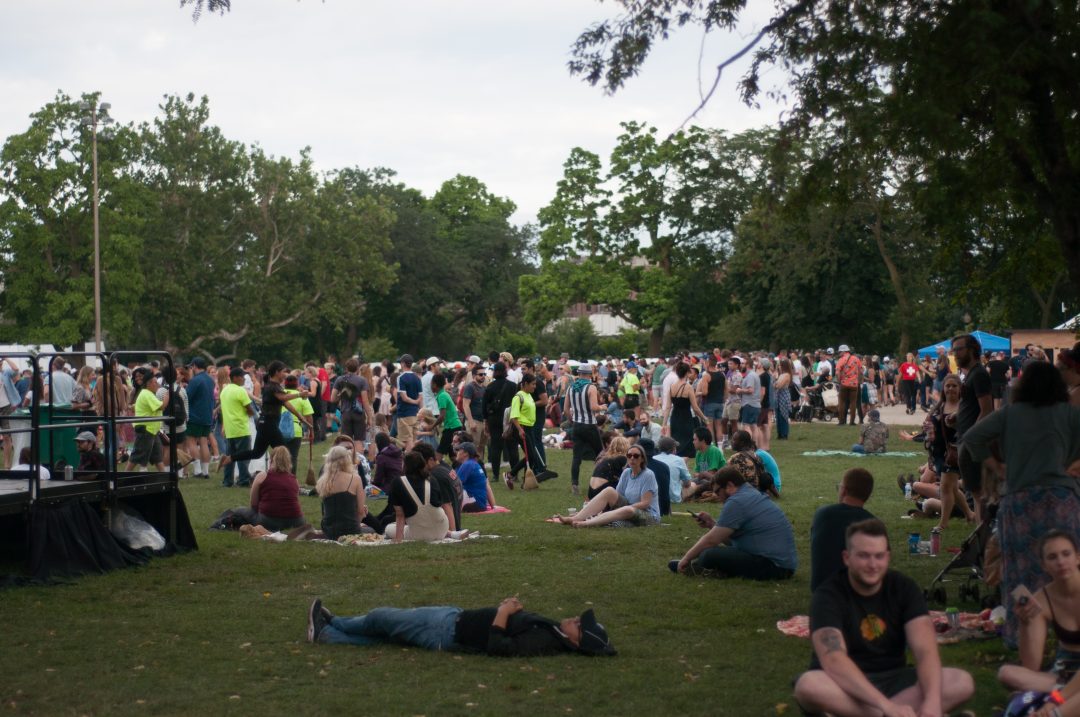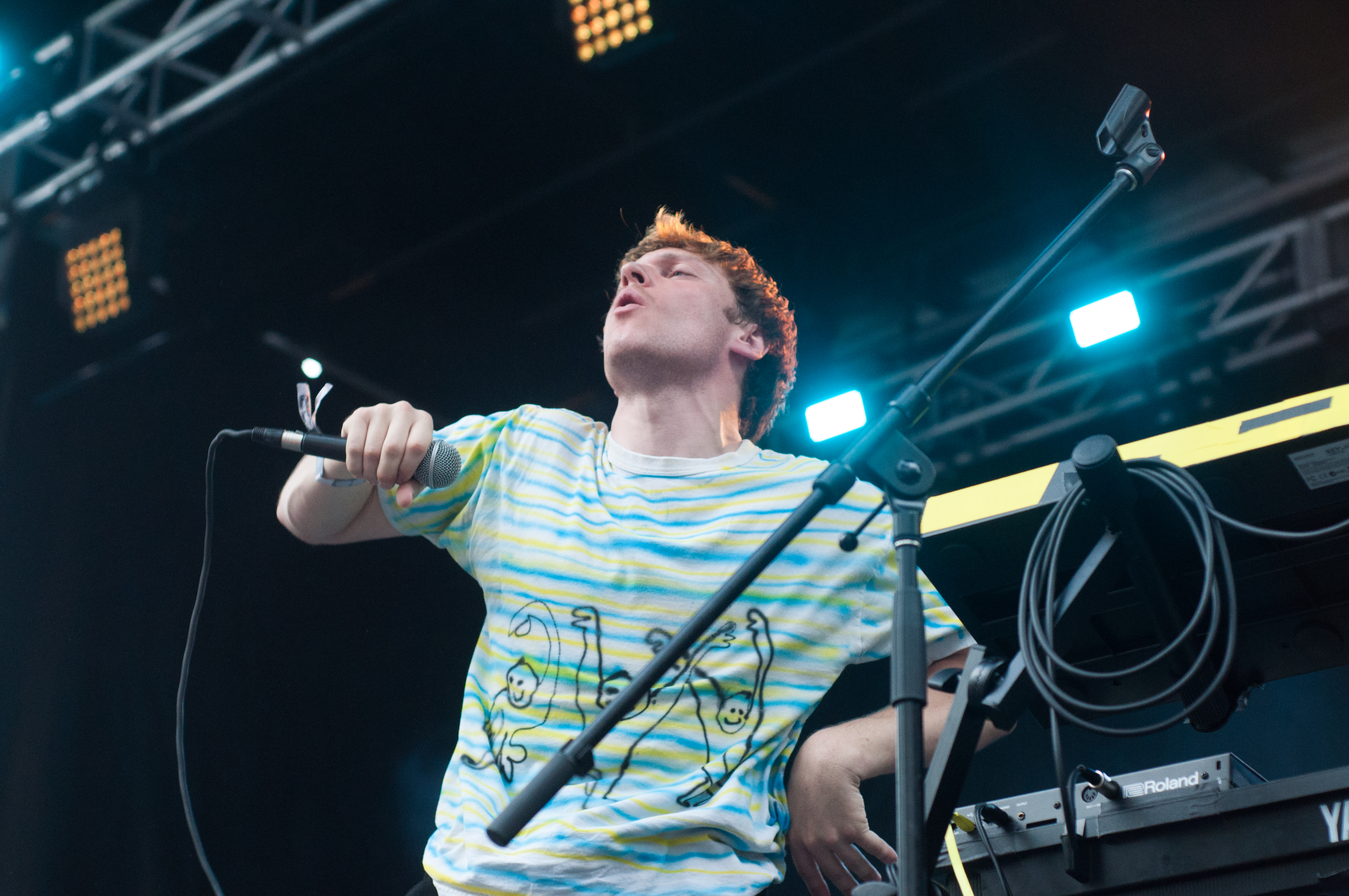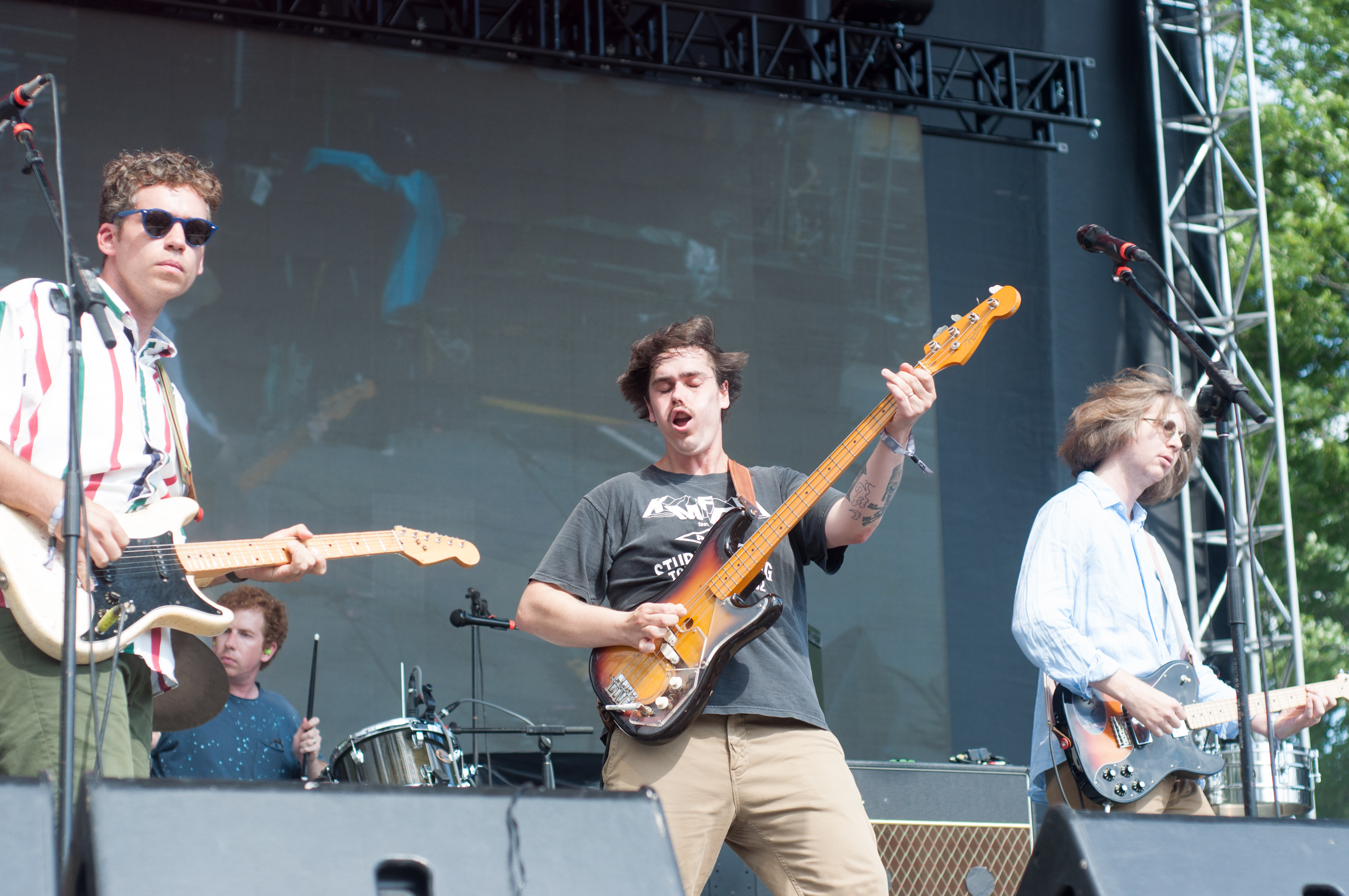
At Pitchfork Music Festival, a three day event in Chicago’s Union Park hosted by the publication of the same name, I attempted to analyze the ways in which we perceive and interact with music in a public space and to answer the following questions: Is Pitchfork a ploy to steal money from a hipster audience? Is Pitchfork becoming its lavish Chicago counterpart, Lollapalooza?
I left the festival even more confused and with more questions than answers. It was difficult to enjoy Pitchfork purely as a music festival because nearly everyone could only voice complaints about the festival’s evolution. If anything, my experience this year has allowed me to reflect on what it means to attend a festival at a moment of transition.
Contradictions defined Pitchfork. Many that I met relentlessly criticized the festival both for its growing tendency to appeal to a broader audience and to commercialize nearly every aspect of the “festival experience.” Yet, these same people were in attendance. For example, the VIP section reserved for those who paid more than the general public has been steadily growing in size and scope over the years. Additionally, the band Parquet Courts designed a beer that was sold exclusively at Pitchfork to promote their latest album and to raise money for Freedom for Immigrants. When the same group that has blasted capitalism and consumer culture in its songs designs an expensive beverage, does this constitute a contradiction? Finally, there is Pitchfork’s public appearance. It is impossible not to wonder if the way it brands itself as a selfless, indie publication is a farce. The festival and the eponymous company have
long been hailed for their artistic integrity and ingenuity, their support for emerging and veteran musicians alike and their failure to succumb to capitalist vice. In short, Pitchfork has often been described (or hailed itself) as the exception of more inane publications. I only wish to evaluate the festival from every possible angle and to view these assumptions with heightened scrutiny to see if there is any truth to the critiques I heard.
I often found myself torn between happiness, annoyance and confusion. It could have been easy to acknowledge Pitchfork’s increasing commercialization and then have a good time, but most were determined to punish this trend through rants and discontent. I found myself loving and hating this year’s festival simultaneously, and I suspect that most contemporary music festival-goers have felt the same. Maybe next year you can do what I did: stumble around the park seeing great music, hate yourself for participating in a music festival in any capacity and attempt to decipher whether you feel incredibly depressed or incredibly exhilarated.
FRIDAY
After arriving Friday afternoon, I first saw Standing on the Corner. I had listened to them briefly beforehand, but I doubted that a live performance could live up to the highly edited quality of their recorded music. The director that managed the individual groups of musicians ran frantically back and forth checking mics. When certain members would play too quietly, loudly or off key, he would run to them, gesturing elaborately with his hands to indicate the problem and solution simultaneously. In this regard, the performance felt somewhat micro-managed. I stayed for half of the set before I was drawn to another corner of the festival by an alien noise: Rico Nasty’s opening songs.

Although I am barely familiar with Rico Nasty’s music, her performance was pleasantly surprising. The rhythms were simple and catchy, and her rapid movements across the stage urged members of the crowd to jump in every direction. The show was not crass, risqué or vulgar. If anything, Rico, in true form, was completely unapologetic about her music, her clothes and the joint she enjoyed on stage. She displayed an impressive indifference to anything that was not laudation from hermost enthusiastic fans. Despite the infectious chaos of the crowd and Rico’s lyrical candor, I had my fill after about fifteen minutes.
Between sets I encountered what would be the first of many instances of delusion. I met a friend of a friend who proceeded to rant about the capitalist nature of this festival and its crimes against musicians. But her very presence at the festival was proof that this tirade was a front, intended to convince others that she was here to rebel. And, as I met more and more people, this half-hearted revolutionary sentiment proved to be commonplace. I found it amusing that, despite having paid to attend, they could not shake this resentful outlook.
After this encounter, I made my way to the other corner of Union Park where Grapetooth was getting ready to take the stage. Native to Chicago, Grapetooth embodies all of the high-strung energy typically associated with post-punk, along with the crazed melodies of eighties synth-pop. They opened with “Violent,” one of their more popular tunes. Song after song elevated the crowd to a state of frenzied excitement, and guitarist/vocalist Clay Frankel’s spastic motions on stage maintained steady support.

On my way to catch Earl Sweatshirt, I felt guilty for not knowing more of his songs, but the set put my anxieties at ease. Earl’s performance was assuredly subdued, and his set inspired a comforting nostalgia located sometime within the early 2010’s. His incisive lyrics coupled with his slow, intentional movements on stage made anyone within a five-mile radius gaze and wonder. Earl’s talent lies not in his ability to inspire support through a pounding bass and infectious track; his allure is contingent on the way he incorporates personal experiences into his music.
Despite Earl’s refreshing performance, at this point everything seemed to melt in the heat. Everyone dripped copious amounts of sweat that pooled in hidden places. Young people with sullen looks on their faces seemed determined to not enjoy themselves. The weather may have contributed to this attitude, but it was also reflective of the Marxist sentiments that they exchanged throughout the day.
Low rallied the drowsy, sun drunk spectators. Their placid opening songs quickly evolved into something more improvised, ambient and enthralling. They entranced the crowd with improvised riffs, piercing guitar notes and a captivating light show. For nearly ten minutes the only sound was that of a whining guitar as lead singer Alan Sparhawk proved his talent. Perhaps here is where we may thank Pitchfork for recruiting bands that would not normally play at conventional music festivals. Low’s performance was highly intimate and perfectly encapsulated the best Pitchfork has to offer: unique performances, small audiences and a frenzied sense of urgency that fuses the two.
SATURDAY
The heat had not subsided as I arrived on Saturday. To wear a long, dark dress in ninety degree weather is to suffer, but, if Cate le Bon was suffering, she made no visible display of it.. Staunch defiance appeared to be a key component of le Bon’s modus operandi.

Belting unflinching lyrics in inflections that cycled through anger, desire and release, le Bon transported sweltering festival-goers to a location entirely chilling and personal. Her music lost none of its bite in a live performance, and, if anything, the heat amplified her trademarked callousness.
This was my third or fourth time seeing Parquet Courts, but I had never viewed the band in a negative light until seeing them at Pitchfork. Reminiscing on “Whit Awake,” their promotional beer at Pitchfork, I began to doubt the band’s integrity. They make music that is fast and appealing to anyone interested in post-punk. However, recently it seems that the members have grown nearly divine in hubris. Nevertheless, the performance mimicked what I had seen in past shows. It is presumptuous to condemn them so hastily as “sellouts” when so many other musicians would also design an overpriced beer if given the opportunity, but it does make you question whether their lyrics about consumer culture are true to the group’s actual opinions.

The set ended early. Billowing storm clouds swarmed the park, and a voice over the intercom system issued an evacuation. My friends and I hugged the interior sides of a vendor’s tent, amusing ourselves with games and making proud display of discontent, until security forced us to leave.
As we waited outside, a security head announced that the festival was closed for the day but insisted that we check social media for updates on a potential reopening. While he said this, sunlight scorched his back and shoulders. The day was beginning to pry itself open, and within five minutes there was no trace of the storm except for the damp grass. Sensing the deceit, we waited outside for about twenty minutes. Upon hearing cries of joy at the front of the crowd, lines began to form, and we re-entered after a cursory check.
Stereolab played a shorter set because of the rain, although this did not diminish the quality of their performance. The band has successfully fused pop, rock, lounge and a mess of other genres, and their show highlighted this combination beautifully. The friendly foreign group cured damp festival-goers of their annoyance towards the weather. After the first song, everyone had forgotten about the prolonged interruption. A surprising amount of the crowd was familiar with Stereolab’s discography, and joyous cries accompanied every song.
If Stereolab had not cured everyone of their melancholy, Belle & Sebastian assuredly did. Nostalgia was contagious, and everyone danced without inhibition. I was not as impressed as older members of the crowd, but the harmonies and simple melodies were infectious nonetheless. This folk respite was well-deserved and timeless, despite the years passed since the release of their album “If You’re Feeling Sinister.” There was enough warmth to satisfy even the most hardened cynicism.
The Isely Brothers closed the day with a soulful, anachronistic performance. The turnout was surprising for a group whose popularity reached its apex decades prior. The members put on an entertaining show with dancers, studded white costumes and a limitless pool of energy. It was not my favorite performance, but it was enough to realize that “Twist and Shout” is not their only song worth a listen.
SUNDAY
Everything was almost over. There was not enough time to rant about the failures or successes of this year’s festival. The only thing left to do was to enjoy it for what it was. I caught the last part of Chicago-based Tasha’s set. Her performance was glowing, endearing and innocent. She thanked the crowd profusely throughout her set, commenting on her past experiences attending Pitchfork. Her heartfelt songs created a soothing, dream-pop landscape where emotion and vulnerability were the sole components. Her shy stage presence came off as nothing but charming.

I had not listened to Clairo previously. I assumed she created the same sort of indie, bedroom pop that many high schoolers idealize. Despite my reservations, Clairo displayed a profound maturity on stage.Her vocals were soft, yet piercing. Something about her put the audience at ease, myself included. I am not sure if it was her mannerisms or the music, but I felt just as comfortable two feet from her as I would have been having dinner with an old friend.
There could not have been a colder followup to Clairo than Amen Dunes. His vocals were a little shaky at first, and the crowd seemed somewhat apathetic. As both he and the crowd warmed up to each other, his voice became increasingly ethereal. Dunes came off as a detached, apathetic artist, a common trope of the indie rock community. This did not detract from his performance; he assumed the role with a hint of irony. Some of his songs ran together without clear endings and beginnings, which made his set sound a little haphazard at times.

In preparation for a flight later that night, the last artist I was able to see was the Chicago-native group, Whitney. Whitney has long been a proponent of the slower, more introspective side of contemporary rock and folk, and their set this year lacked any excitement. The band appeared to be going through the motions without giving thought to where they were or what they were doing. The distinct, whining vocals of drummer and vocalist Julien Ehrlich are crucial to their success, yet their low-energy made the performance seem like a chore. I left the festival shortly afterwards, worrying that Whitney’s lackluster performance may serve as more evidence of Pitchfork’s fall from grace.
TAKEAWAY
I felt delirious at the airport. I accepted that this event has grown beyond the comfortable confines of Union Park. Pitchfork’s trajectory seems destined to coincide with Lollapalooza, a festival that many self-respecting music connoisseurs have reviled for years. Then again, this sort of behavior is expected. It is only the contradiction, the way that Pitchfork presents itself as a supportive and inclusive publication and festival, that is note-worthy. If these sorts of marketing ploys are present at every modern festival, why were so many angry this year?
In short, it is the history. The history of Pitchfork as an independent, cutting-edge publication, concerned more with journalistic integrity than sensationalism, is to blame for the resentment. As this facade begins to crumble, former proponents have no choice but to aid in its dismantling. Otherwise, they face a crueler sentence: supporting an entity that is now mainstream. It is the way in which people respond to this disappointment, through vocal rebellion, willful ignorance or a combination of the two, that reflects our fear: nothing can be worthwhile and hidden forever.
Subscribe to the Mossy Log Newsletter
Stay up to date with the goings-on at Lewis & Clark! Get the top stories or your favorite section delivered to your inbox whenever we release a new issue.

Leave a Reply